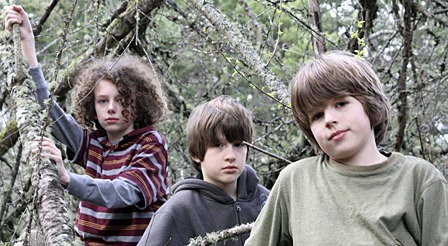Liam Griskey-Watson was sitting on a branch when he noticed a large blob of fungus in the wetland below him.
He called over to his older brother Holden and their friend, Eamon Morris, and directed their attention to the floating mass.
Morris then noticed swarms of tiny, translucent crustaceans swimming in the murky water.
“Moments later, we heard Holden running full tilt up to the house, yelling, ‘Get the net!’” said the brothers’ father, Shane.
The trio of young naturalists caught some of the miniature shrimp for further inspection, but no one could positively identify them. After posting a photo on Facebook, a family friend in California provided the answer: fairy shrimp.
It turned out to be a notable discovery, as only one species of fairy shrimp has been identified in San Juan, Skagit and Whatcom counties. It may be that this single species is actually several genetically isolated populations. As new research on fairy shrimp genetics gets underway, more “cryptic” species are being discovered that look alike, but are genetically different from each other.
“While some biologists have occasionally encountered fairy shrimp in the islands, until now there have been no collections or genetic analyses,” said Russel Barsh of the research group Kwiáht. “Some of the vernal pools where fairy shrimp were apparently seen in the past, no longer exist.”
The Orcas fairy shrimp are being studied by a team including Barsh and Madrona Murphy of Kwiáht, Lopez wetland scientist Scott Rozenbaum, Bellingham-based wetland scientists Vikki Jackson and Elizabeth Binney, and, of course, the boys who discovered them.
Since their late December find, Holden, 12, Liam, 10, and Morris, nine, have been monitoring the shrimp. The population has dwindled, as their normal life span is short.
“They go dormant and die off after they lay their eggs,” Morris said.
Over the next year, the Deer Harbor-Turtleback area will be explored for more fairy shrimp pools.
If the shrimp found in the boys’ wetland proves to be a cryptic species, they hope it will be named after them. “Holiamon” is their first choice.
“We found them, not just because we are lucky, but because we are interested in them,” Holden said. “We wanted to find out what they were.”
Fairy shrimp (Anostracans) are crustaceans, like true shrimp, crabs, crayfish, “sand fleas” (amphipods), and many animals so small that they are rarely noticed in our lakes, wetlands, and bays. Fairy shrimp, generally under half an inch long, are specially adapted to wetlands that dry out in the summer, called “vernal pools.”
Fairy shrimp hatch from eggs in the mud when the rains begin in fall. By mid-winter, they are mating, and the females can be seen carrying an oval sac of eggs on the base of their tails. The eggs are released into the mud, where they can remain dormant until the following winter. The crustraceans live only a few months.
Fairy shrimp are “extremophiles,” meaning they survive in conditions that other animals cannot. But like other extremophiles, fairy shrimp are not very competitive in “normal” habitats, such as year-round lakes, ponds and wetlands.
“They are always living on the edge,” Barsh said. “This makes them special, and very vulnerable. They need a little water most years to survive, but too much water can result in fairy shrimp being overcome by other aquatic animals.”
In California, where fairy shrimp have become a significant conservation issue, there are at least seven endangered species.
Liam and Holden say they are lucky to have access to the five-acre wetland that is owned by Suncrest, the Deer Harbor community where they live. Nearly an acre of it is adjacent to their family’s land. During their many explorations, they’ve found huge tree frogs, dragonflies, and newts.
Not surprisingly, all three boys plan to work in the animal sciences when they grow up.
“I want to be a geneticist, Liam wants to be a marine biologist, and Eamon wants to work with animals,” Holden said.



